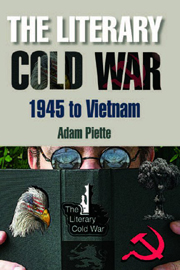Book contents
- Frontmatter
- Contents
- Acknowledgements
- Introduction
- 1 The Special Relationship and the British Hypothesis: The Black Laurel, The Third Man, Cold War Vienna and Berlin
- 2 Cold War on the 1930s and Sacrificial Naming: John Dos Passos and Josephine Herbst
- 3 DEW Line, Uranium and the Arctic Cold War: Ginsberg's Kaddish and Nabokov's Lolita
- 4 Cold War Sex War, Or the Other Being Inside: Burroughs, Paley, Plath, Hughes
- 5 The Sacrificial Logic of the Asian Cold War: Greene's The Quiet American and McCarthy's The Seventeenth Degree
- Conclusion
- Bibliography
- Index
2 - Cold War on the 1930s and Sacrificial Naming: John Dos Passos and Josephine Herbst
Published online by Cambridge University Press: 12 September 2012
- Frontmatter
- Contents
- Acknowledgements
- Introduction
- 1 The Special Relationship and the British Hypothesis: The Black Laurel, The Third Man, Cold War Vienna and Berlin
- 2 Cold War on the 1930s and Sacrificial Naming: John Dos Passos and Josephine Herbst
- 3 DEW Line, Uranium and the Arctic Cold War: Ginsberg's Kaddish and Nabokov's Lolita
- 4 Cold War Sex War, Or the Other Being Inside: Burroughs, Paley, Plath, Hughes
- 5 The Sacrificial Logic of the Asian Cold War: Greene's The Quiet American and McCarthy's The Seventeenth Degree
- Conclusion
- Bibliography
- Index
Summary
In his 1946 wartime memoir, Tour of Duty, John Dos Passos as war correspondent for Life Magazine recalls one of the most extraordinary sights to be seen in the Pacific theatre of war, the floating base at Ulithi:
As we slow down to approach the entrance to the anchorage, radar grids and gray masts and stacks and turrets bristling with guns rise out of the sea. We begin to make out a line of battleships and beyond them the great barns of aircraft carriers, planes with folded wings crowded close on their decks as bees swarming on a hive. There is a tangle of destroyers hull down far to the south behind ranks of long low tankers. In the broad lanes between whaleboats, bluntnosed landing craft of every size and description, tugs, destroyer escorts, patrol boats, stagger in a chain of white water through choppy seas. It's like steaming into a great port, New York or Liverpool, except there's no land, only a few drowned islets fringed with coconut palms along the reef.
Dos Passos' awe at this mirage of a floating metropolis in the middle of the vast Pacific – he's as staggered as those little boats at the immense chain of ships in their lines and ranks – is tempered by his faint efforts to domesticate the scene with his farmyard allusions to hive and barn.
- Type
- Chapter
- Information
- The Literary Cold War 1945 to Vietnam , pp. 47 - 73Publisher: Edinburgh University PressPrint publication year: 2009



